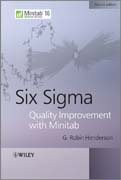
This book aims to enable readers to understand and implement, via the widely used statistical software package Minitab (Release 16), statistical methods fundamental to the Six Sigma approach to the continuous improvement of products,processes and services. The second edition includes the following new material: Pareto charts and Cause-and-Effect diagrams Time-weighted control charts cumulative sum (CUSUM) and exponentially weighted moving average (EWMA) Multivariate control charts Acceptance sampling by attributes and variables (not provided in Release 14) Tests of association using the chi-square distribution Logistic regression Taguchi experimental designs INDICE: Foreword Preface Acknowledgements About the author Chapter 1 - Introduction1.1 Quality and quality improvement1.2 Six Sigma quality improvement1.3 The Six Sigma roadmap and DMAIC1.4 The role of statistical methods in Six Sigma1.5 Minitab and its role in the implementation of statistical methods1.6 Exercises and follow-up activities Chapter 2 - Data display, summary and manipulation2.1 The run chart - a first Minitab session2.2 Display and summary of univariate data2.3 Data input, output, manipulation and management2.4 Exercises and follow-up activities Chapter 3 - Exploratory data analysis, display and summary of multivariate data 3.1 Exploratory data analysis3.2 Display and summary of bivariate and multivariate data3.3 Other displays3.4 Exercises and follow-up activities Chapter 4 - Statistical models4.1 Fundamentals of probability4.2 Probability distributions for counts and measurements4.3 Distributions of means and proportions4.4 Multivariate normal distribution4.5 Statistical models applied to acceptance sampling4.6 Exercises and follow-up activities Chapter 5- Control charts5.1 Shewhart charts for measurement data5.2 Shewhart charts for attribute data5.3 Time-weighted control charts5.4 Process adjustment5.5 Multivariate control charts5.5 Exercises and follow-up activities Chapter 6 - Process capability analysis 6.1 Process capability6.2 Exercises and follow-up activities Chapter 7 Process experimentation with a single factor7.1 Fundamental concepts in hypothesis testing7.2 Tests and confidence intervals for the comparison of means and of proportions with a standard7.3 Tests and confidence intervals for the comparison of two means or two proportions7.4 The analysis of paired data - t-tests and sign tests7.5 Experiments with a single factor having more than two levels7.6 Blocking in single factor experiments7.7 Experiments with a single factor, with more than two levels, where the response is a proportion7.8 Tests for equality of variance7.9 Exercises and follow-up activities Chapter 8 - Process experimentation with two or more factors8.1 General factorial experiments.8.2 Full factorial experiments in the 2k series 8.3 Fractional factorial experiments in the 2k-p series8.4 Taguchi experimental designs 8.5 Exercises and follow-up activities Chapter 9 - Evaluation of measurement processes9.1 Measurement process concepts9.2 Gage repeatability and reproducibility (R&R) studies 9.3 Comparison of measurement systems9.4 Attribute scenarios9.5 Exercises and follow-up activities Chapter 10 - Regression and model building10.1 Regression with a single predictor variable 10.2 Multiple regression10.3 Response surface methods10.4 Categorical data and logistic regression10.5 Exercises and follow-up activities Chapter 11 - Learning more and further Minitab11.1 Learning more about Minitab and obtaining help11.2 Macros11.3 Further features of Minitab11.4 Quality Companion11.5 Postscript Appendices References Index
- ISBN: 978-0-470-74175-7
- Editorial: John Wiley & Sons
- Encuadernacion: Cartoné
- Páginas: 520
- Fecha Publicación: 29/07/2011
- Nº Volúmenes: 1
- Idioma: Inglés
